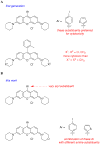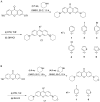Rosamines targeting the cancer oxidative phosphorylation pathway
- PMID: 24622277
- PMCID: PMC3951181
- DOI: 10.1371/journal.pone.0082934
Rosamines targeting the cancer oxidative phosphorylation pathway
Abstract
Reprogramming of energy metabolism is pivotal to cancer, so mitochondria are potential targets for anticancer therapy. A prior study has demonstrated the anti-proliferative activity of a new class of mitochondria-targeting rosamines. This present study describes in vitro cytotoxicity of second-generation rosamine analogs, their mode of action, and their in vivo efficacies in a tumor allografted mouse model. Here, we showed that these compounds exhibited potent cytotoxicity (average IC50<0.5 µM), inhibited Complex II and ATP synthase activities of the mitochondrial oxidative phosphorylation pathway and induced loss of mitochondrial transmembrane potential. A NCI-60 cell lines screen further indicated that rosamine analogs 4 and 5 exhibited potent antiproliferative effects with Log10GI50 = -7 (GI50 = 0.1 µM) and were more effective against a colorectal cancer sub-panel than other cell lines. Preliminary in vivo studies on 4T1 murine breast cancer-bearing female BALB/c mice indicated that treatment with analog 5 in a single dosing of 5 mg/kg or a schedule dosing of 3 mg/kg once every 2 days for 6 times (q2d×6) exhibited only minimal induction of tumor growth delay. Our results suggest that rosamine analogs may be further developed as mitochondrial targeting agents. Without a doubt proper strategies need to be devised to enhance tumor uptake of rosamines, i.e. by integration to carrier molecules for better therapeutic outcome.
Conflict of interest statement
Figures






References
-
- Nahta R, Esteva FJ (2007) Trastuzumab: triumphs and tribulations. Oncogene 26: 3637–3643. - PubMed
-
- Alcala AM, Flaherty KT (2012) BRAF inhibitors for the treatment of metastatic melanoma: clinical trials and mechanisms of resistance. Clin Cancer Res 18: 33–39. - PubMed
-
- Ayoola A, Barochia A, Belani K, Belani CP (2012) Primary and acquired resistance to epidermal growth factor receptor tyrosine kinase inhibitors in non-small cell lung cancer: an update. Cancer Invest 30: 433–446. - PubMed
-
- McBride HM, Neuspiel M, Wasiak S (2006) Mitochondria: more than just a powerhouse. Curr Biol 16: R551–560. - PubMed
Publication types
MeSH terms
Substances
Grants and funding
LinkOut - more resources
Full Text Sources
Other Literature Sources

